|
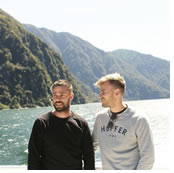 A Gay Travel New Zealand Cultural Tour. Experience epic natural beauty and rich cultural heritage on our Vineyards and Vistas gay tour of New Zealand. Epic natural beauty fills these distant islands in the Pacific southwest. On our New Zealand gay tour we will explore this unique landscape, encounter the unique melding of British and Pacific cultures, and enjoy the friendliness of the Kiwis who love their country intensely. On this Gay cultural tour of New Zealand, we travel from the sail-filled harbor of Auckland to charming Wellington, the capital. Then, after a brief stop in Dunedin to see albatrosses and penguins, we travel to the adventure capital, Queenstown, a mountain jewel set on a large glacial lake. A Gay Travel New Zealand Cultural Tour. Experience epic natural beauty and rich cultural heritage on our Vineyards and Vistas gay tour of New Zealand. Epic natural beauty fills these distant islands in the Pacific southwest. On our New Zealand gay tour we will explore this unique landscape, encounter the unique melding of British and Pacific cultures, and enjoy the friendliness of the Kiwis who love their country intensely. On this Gay cultural tour of New Zealand, we travel from the sail-filled harbor of Auckland to charming Wellington, the capital. Then, after a brief stop in Dunedin to see albatrosses and penguins, we travel to the adventure capital, Queenstown, a mountain jewel set on a large glacial lake.
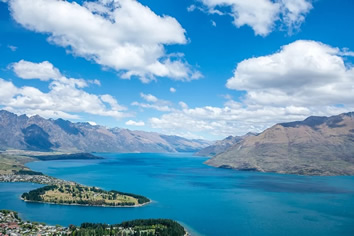
We start our journey in the largest city, Auckland jumping right into the delectable world of New Zealand wine tastings on charming Waiheke Island.
Then, in Wellington, our harbor front hotel gives us quick access to an immersive tour into the culture and treasures of the native Maori and the city’s café culture. We will explore hidden culinary treasures and artistic personalities on a walking tour of the city center.
Flying south, we arrive in the university city of Dunedin, focusing on the Otago Peninsula, home to penguins and the only mainland colony of albatross in the Southern Hemisphere.
Then in Queenstown, we find ourselves on an immense glacial lake surrounded by Lord of the Rings landscapes. The great expanse of this rugged landscape is revealed on our short flight to Milford Sound, where we cruise out to the Tasman Sea and back, getting sprayed by epic waterfalls as we pass nearby. We return to Queenstown to relax and celebrate the wonders of New Zealand all while soaking up some of the most beautiful landscapes in the world!

• Sail in Auckland Harbor to the artist and vineyard enclave of Waiheke Island
• Savoir the delicious offerings of wine throughout New Zealand.
• Taste our way through Wellington’s unique gourmet shops and craft eateries
• Be inspired by the unique culture of the native Maori
• Visit the only castle in New Zealand, Larnach Castle and its magnificent gardens
• Encounter penguins on the beaches as they return to shore at sunset
• Cruise through a stunning fjord, Milford Sound
• Explore small boutique towns full of rich culture
• Relax on a vintage 1912 steamship cruise to tour a beautifully sited historic sheep station
• Venture into vast gardens and take in the sights, aroma, and creativity

Day 1 -
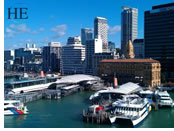 After the long flight, we will take it easy until this evening, when we walk to our waterside restaurant to enjoy our Welcome Dinner. After the long flight, we will take it easy until this evening, when we walk to our waterside restaurant to enjoy our Welcome Dinner.
Our centrally located luxury hotel is a great base to walk and explore the waterfront and the main core of the city.
Known as the ‘City of Sails’, Auckland extends over a narrow isthmus of land between the Pacific Ocean the Tasman Sea, that includes 49 dormant volcanoes. This cosmopolitan city has a population of around 1.4 million. And the city’s subtropical climate, lush vegetation and easy access to the coast and outdoor activities consistently earns it a place in the top five rankings in international lifestyle surveys. A melting pot of 190 different ethnicities, Auckland is the world’s biggest Polynesian city. This diversity is reflected in the lively arts and culture scene, a wide range of food and craft markets, vineyards, a hip cafe culture and outstanding restaurants. The dozens of islands of the Hauraki Gulf form a distinctive aspect of the Auckland landscape and provide a magnet for those who sail, fishing enthusiasts and hikers.
Day 2 -
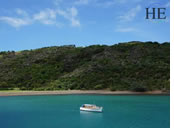 Today we head to the Today we head to the Downtown Auckland Ferry Terminal to go on a lovely 40-minute cruise to Waiheke Island through the picturesque Hauraki Gulf, a surprisingly refreshing escape so close to a major city, containing beautiful beaches, dozens of vineyards, olive groves, native bush, and relaxing seaside villages. Upon arrival, we will be met by a local island tour guide who will reveal the island to us throughout our stay. Today we head to the Today we head to the Downtown Auckland Ferry Terminal to go on a lovely 40-minute cruise to Waiheke Island through the picturesque Hauraki Gulf, a surprisingly refreshing escape so close to a major city, containing beautiful beaches, dozens of vineyards, olive groves, native bush, and relaxing seaside villages. Upon arrival, we will be met by a local island tour guide who will reveal the island to us throughout our stay.
We will have tastings at several vineyards, including a nice lunch at one of the vineyards, celebrating the fresh produce, lovely herbs, and excellent meats all grown here in New Zealand. If time allows, we may also wander through a local sculpture garden or stop for unending views at a gin distillery.
Day 3 -
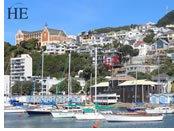 This morning we will fly to the southern tip of the North Island, to the country’s capital, Wellington. Situated on a beautiful harbor, the city is known for its boutique café and gourmet restaurant culture, its vibrant arts scene, and an outdoor lifestyle. Just beyond the main waterfront, the city is surrounded by mountains. Homes perch precariously as they climb ever higher on the hillsides. But the central core of the city is easily walkable. Despite being a larger city, Wellington pulses with a warm and welcoming heart. This morning we will fly to the southern tip of the North Island, to the country’s capital, Wellington. Situated on a beautiful harbor, the city is known for its boutique café and gourmet restaurant culture, its vibrant arts scene, and an outdoor lifestyle. Just beyond the main waterfront, the city is surrounded by mountains. Homes perch precariously as they climb ever higher on the hillsides. But the central core of the city is easily walkable. Despite being a larger city, Wellington pulses with a warm and welcoming heart.
This afternoon, we discover fresh tastes in New Zealand’s café capital as our local guide and gourmet guru introduces us to the city, its local tastes, products, and people. Stroll behind the scenes at some favorite Wellington food places, taste hidden culinary treasures, and meet some of the people behind a selection of the city’s best food.
Wellington has a small gay scene, so in the evenings a few of us may go out and visit with the locals.
Day 4 -
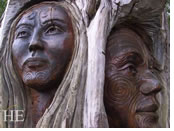 This morning we will make our way to Te Papa Tongarewa, New Zealand’s national museum, for a unique hosted cultural tour that will tell us the story of the Maori people through remarkable Maori taonga (historical treasures). Explore other floors and get a deeper understanding of today’s melding of the Maori culture of the Pacific and British colonial values and traditions. The afternoon is free for you to explore the city, to enjoy the waterfront, and perhaps take the tram up for a wander among the botanical gardens. This morning we will make our way to Te Papa Tongarewa, New Zealand’s national museum, for a unique hosted cultural tour that will tell us the story of the Maori people through remarkable Maori taonga (historical treasures). Explore other floors and get a deeper understanding of today’s melding of the Maori culture of the Pacific and British colonial values and traditions. The afternoon is free for you to explore the city, to enjoy the waterfront, and perhaps take the tram up for a wander among the botanical gardens.
This evening we gather for dinner at one of Wellington’s best restaurants.
Day 5 -
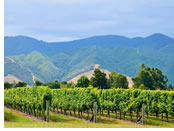 Another day in Wellington allows time to continue to explore they city on your own, its galleries, shops and other museums, relax and enjoy a walk along the waterfront to the beach at Oriental Parade and further out to outlying bays, or maybe a longer walk on part of the City to Sea walkway. Another day in Wellington allows time to continue to explore they city on your own, its galleries, shops and other museums, relax and enjoy a walk along the waterfront to the beach at Oriental Parade and further out to outlying bays, or maybe a longer walk on part of the City to Sea walkway.
Most of us, however, will escape to nearby Martinborough for the day, a delightful country village less than an hour from the city. Our guide will show off the area, introduce to a few local vineyards and stop at an olive oil farm, allowing us to get a feel for the quieter life in the New Zealand countryside. Afterward, we return to Wellington.
Day 6 -
 On this morning’s flight south to Dunedin, we pass over Cook Strait, separating the North Island from the South Island, and then over extensive pastoral lands and parts of the eastern coast. On this morning’s flight south to Dunedin, we pass over Cook Strait, separating the North Island from the South Island, and then over extensive pastoral lands and parts of the eastern coast.
Dunedin sits at the head of a long natural harbor that is well protected by the rugged Otago Peninsula. While the Maori settled here centuries ago, the first westerners to settle the area were brought from Scotland in 1848 (by the nephew of Robert Burns, no less). And it is the Scottish who have left their mark. Gold discoveries nearby soon after brought in tens of thousands of others from around the world, all seeking their fortune. However, the area maintains a very Scottish feel and energy, a fervor that we experience all the way into Queenstown.
We will enjoy a late lunch in a historic property with gardens, followed by a tour of New Zealand’s only castle. An Australian banker who profited from the gold rush built lavish Larnach Castle in 1871. The 40,000 square foot home has commanding views, great gardens, and a unique history. Later, we check into our hotel, located in the wonderfully renovated main post office building not far from the Octagon, Dunedin’s central plaza.
Day 7 -
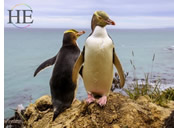 An open morning today to sleep in or to wander and explore Dunedin. Check out the architecturally eclectic, revived Flemish-inspired train station dating from the early 1900’s and the peaceful Octagon, the central square overseen by a statue of Scottish poet Robert Burns. Enjoy a self-guided walking tour of the internationally acclaimed Street Art dotted around the city. An open morning today to sleep in or to wander and explore Dunedin. Check out the architecturally eclectic, revived Flemish-inspired train station dating from the early 1900’s and the peaceful Octagon, the central square overseen by a statue of Scottish poet Robert Burns. Enjoy a self-guided walking tour of the internationally acclaimed Street Art dotted around the city.
This afternoon and into the evening we tour the Otago Peninsula. On our visit to a remote Otago Peninsula beach, a short walk provides dramatic views of rugged coastal cliffs, offshore islands and possibly sighting huge sea lions. We then enjoy a special view of the royal albatross breeding colony from a private viewing observatory. Watch as these majestic birds glide past on wingspans more than nine feet across and enjoy their puffball chicks in their nest. Maybe take a walk down to Pilots Beach and see fur seals sunning on the rocks. The final stop is at a Yellow-eyed Penguin Conservation Reserve where we may stop to visit the rehab center before walking trails into the native bushland, through tunnels and trenches where we find viewing hides scattered around the reserve. Watch as the world’s rarest penguin returns ashore and interacts around their nesting sites. You may encounter little blue penguins too (for more sightings of those penguins, check out our Australia Dreams tour). The penguin viewing hikes follow unpaved tracks and less developed trails, so please advise if you have limited mobility. Return to Dunedin later this evening.
Day 8 -
 Our guide will inspire us with views and stories as we drive inland, passing several of the areas where gold was discovered in the 1860s. We then follow one of several glacial rivers that irrigate this eastern side of the South Island, including areas with excellent vineyards. At this point, it may be little surprise that we may stop to enjoy one of the vineyards before continuing to Queenstown, perhaps with a few other stops of interest along the way. Our guide will inspire us with views and stories as we drive inland, passing several of the areas where gold was discovered in the 1860s. We then follow one of several glacial rivers that irrigate this eastern side of the South Island, including areas with excellent vineyards. At this point, it may be little surprise that we may stop to enjoy one of the vineyards before continuing to Queenstown, perhaps with a few other stops of interest along the way.
Queenstown is an alpine city known for its ideal location on glacial Lake Wakatipu, and the towering peaks around it, including the Remarkable Range, which truly lives up to its name. And for its numerous cafes, restaurants, bars, galleries, shops, and all things outdoor extreme, from bungy jumping to river surfing through class IV rapids with a helmet and a kickboard (see our active NZ trip, Wild Kiwi, for those type of adventures!). We will have three nights here.
Sometime during our stay, be sure to take advantage of a gondola ride to a spectacular view high above the town. We include a ticket for you to enjoy the Skyline Gondola, which will whisk you smoothly up 450 metres to Bob’s Peak. From the top, enjoy breath-taking views that extend almost 360 degrees from Coronet Peak around to the Remarkables and on to Cecil and Walter Peaks on the other side of Lake Wakatipu.
In the early evenings, enjoy our boutique hotel’s happy hour with canapes. And their excellent breakfasts each morning.
Day 9 -
 Our goal today is to see Milford Sound, likely New Zealand’s most talked about landscape. If the weather cooperates, we promise you a remarkable day! Our goal today is to see Milford Sound, likely New Zealand’s most talked about landscape. If the weather cooperates, we promise you a remarkable day!
Despite Captain Cook’s misnomer, Milford Sound is really a fjord, one of seventeen or so here on the southwest coast. These huge waterfilled valleys that were carved by behemoth glaciers have almost vertical cliffsides and jagged peaks, much like those in Norway. Multiple waterfalls drop hundreds of feet from those cliff edges. And seals and dolphins often visit the safety of this long ribbon of protected water. Its beauty has earned it designation as a UNESCO World Heritage Area.
We enjoy the immensity of Milford Sound and parts of Fiordland this morning by both air and sea. We fly in small, light aircraft for about 40-minutes over the dramatic Fiordland mountain ranges, valleys, glaciers, and icefields, before arriving at the Tasman Sea. And then we fly up the fjord to our landing strip near the marina. After boarding our small ship, we cruise out to the Tasman Sea and back, watching for marine life, enjoying those sky-scraping cliff tops, and then see who wanders forward on the ship to be blessed by water spray as our ship edges its bow under a tumbling waterfalls.
On our return flight, we see more of Fiordland, including a part of either the famed Milford Trek or the Routeburn Trek, each being one of the ten Great Walks in New Zealand. We might also see Sutherland Falls, which at 1904 feet is one of the tallest waterfalls in the world. The remainder of the afternoon and evening are free to enjoy Queenstown.
Day 10 -
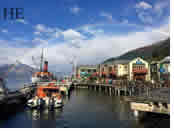 We find ourselves enjoying the peacefulness of morning as we take in the view on a cruise, this time on a huge glacial lake. After crossing to the western shore of Lake Wakatipu on the 1912 Earnslaw, one of the original steamships that provided transportation around the lake to settlers, gold diggers, and even sheep a hundred years ago, we disembark at a historic homestead, and soak in the panoramic views from one of New Zealand’s largest high country farms. We find ourselves enjoying the peacefulness of morning as we take in the view on a cruise, this time on a huge glacial lake. After crossing to the western shore of Lake Wakatipu on the 1912 Earnslaw, one of the original steamships that provided transportation around the lake to settlers, gold diggers, and even sheep a hundred years ago, we disembark at a historic homestead, and soak in the panoramic views from one of New Zealand’s largest high country farms.
Join the handsome farm guide and follow the journey of merino wool in a fun and interactive environment – from mustering sheep to the creation of Icebreaker clothing. Watch sheep being moved by the farmer’s dog and meet and feed working animals used on the farm while learning about daily farming life, which was the historic backbone of the country. Feel free to wander the grounds or along the lake shore. Then return to the waterfront for a bit of tea and bites before the return cruise to Queenstown.
This evening we celebrate our Kiwi adventure together at our farewell dinner at one of the best restaurants in Queenstown.
Day 11 -
Today is the day we say goodbye to this beautiful country. We’ll be collected from our hotel and transferred to Queenstown Airport.
Stay Longer and Join the Australia Sydney Gay and Lesbian Mardi Gras 5 Day Extension
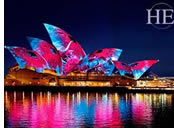 Explore Sydney, a stunning harbor setting with beaches nearby, for a tour of a penal colony on Cockatoo Island and a tour of that architectural icon, the Sydney Opera House. Explore Sydney, a stunning harbor setting with beaches nearby, for a tour of a penal colony on Cockatoo Island and a tour of that architectural icon, the Sydney Opera House.
From sophisticated tasting tours and ” Dreamtime” in the Outback to sunset dinner aboard a private yacht and a fabulous Gay Mardi Gras Parade and party, this trip highlights the wonders Down Under!
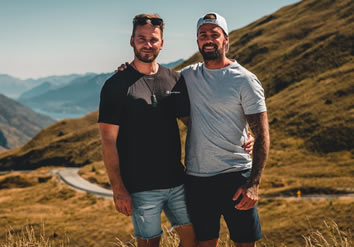
|